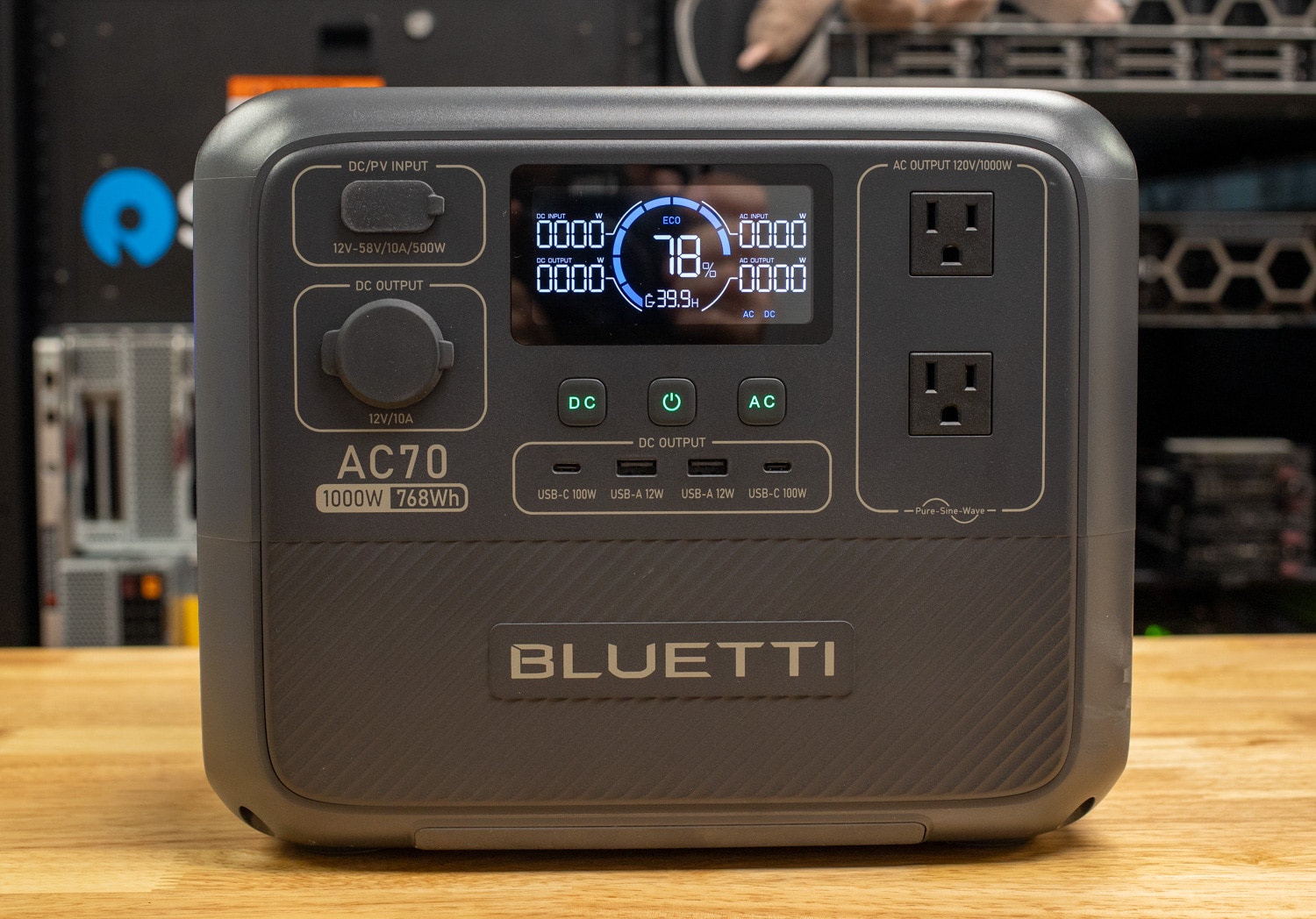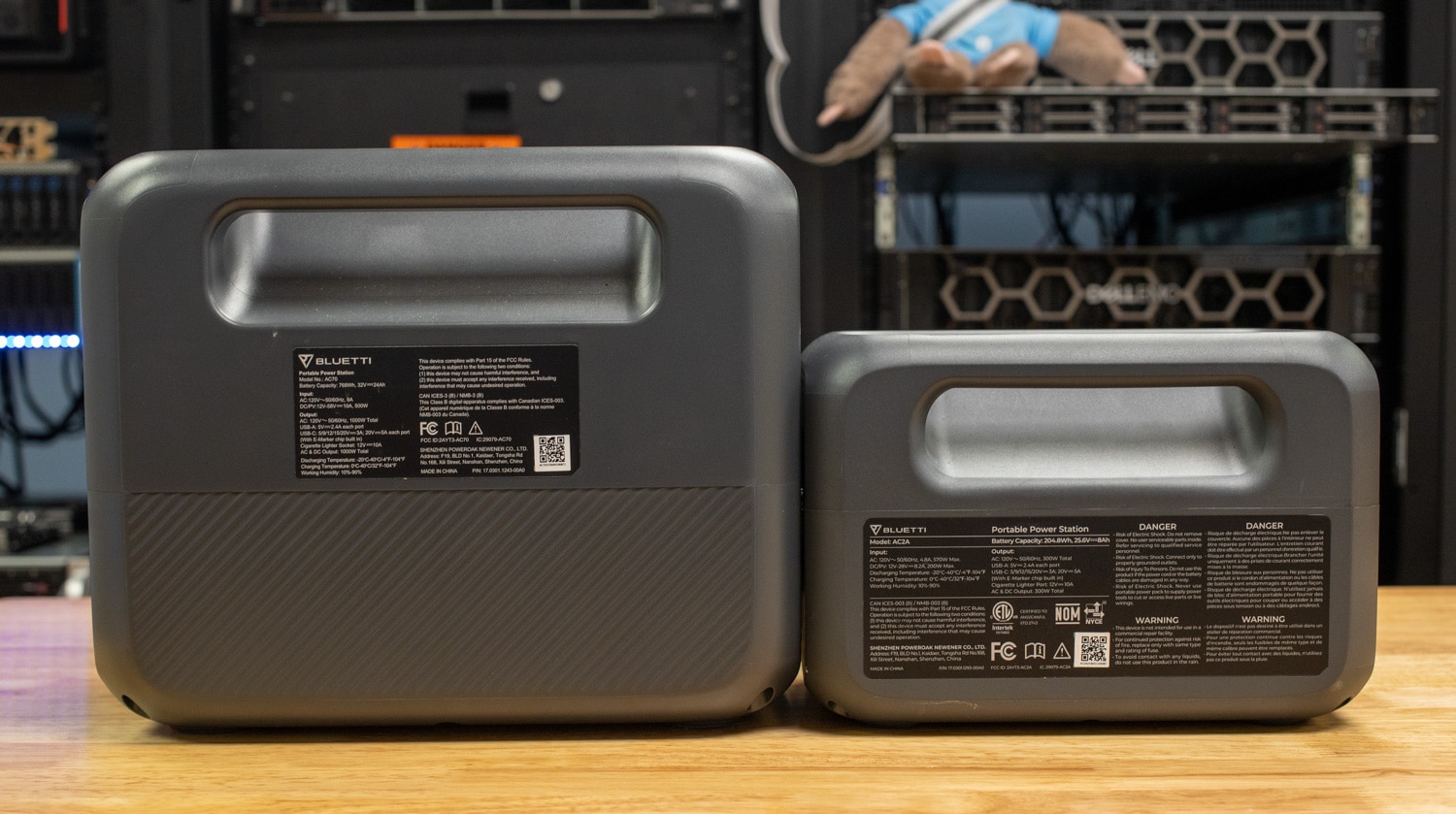The compact 300W Bluetti AC2A and midrange 1000W Bluetti AC70 give users more options when buying the best power station for their situation.
Bluetti has recently added two new portable power station models into their lineup, giving them more reach into the midrange and compact sizes. With a wide range of possible use cases, matching the power requirements of an off-grid project to the correct size power source can solve a lot of headaches. The obvious is if you go too small, you won’t have enough power, but for bite-size projects, it is also handy to have compact options at your disposal. To that end, we will be looking at the Bluetti AC70 with a 768Wh capacity and the new 204Wh AC2A.

Bluetti has an extensive portfolio of portable power stations, ranging from bite-size models such as the new AC2A to house-powering sizes such as the EP500Pro. The advantage of a broad portfolio of offerings is that it gives users a chance to focus on what specific portable power station would work for their particular scenario. That is where the new AC70 and AC2A come in, giving you an updated entry solution and a new mid-range offering. Not all power demands are equal, with some needing the smallest footprint or enough inverter capacity to power certain devices. No matter what your situation requires, there is most likely a Bluetti portable power station for it.

The new Bluetti AC2A comes in at a smaller footprint than the EB3A, although with the current updated design, we’ve seen across models such as the AC180. This includes an integrated handle, a rugged look and feel, and a power port layout. Even the display that organizes watts in and out into a simple-to-understand format is shared across these models. Regarding use cases, the AC2A can handle 300W loads, which works well for smaller accessories.

In an IT fieldwork situation, this could easily power networking PoE hardware to get cameras and other equipment online before AC power is available. The runtime will be shorter, but it’s worth its weight in gold if you can get a job done within the same day.
Bluetti AC2A Specifications
| Battery Info | |
| Capacity | 204.8Wh |
| Type | LiFePO₄ (Lithium-Iron Phosphate) |
| Life Cycles | 3,000+ Cycles to 80% Original Capacity |
| Shelf-life | Recharge to 80% Every 3-6 Months |
| Management System | MPPT Controller, BMS, etc. |
| Output | |
| AC Outlet | 2×120V/2.5A, 300W in Total |
| Inverter Type | Pure Sine Wave |
| Surge Power | 600W |
| USB-C | 1 × 100W Max. |
| USB-A | 2×5V/2.4A |
| 12V DC Outlet | 1 × 12V/10A (Car outlet, regulated.) |
| Input | |
| AC Input | 270W Max. |
| Solar Input | 200W Max., VOC 12-28VDC, 8.2A |
| Car Input | 12/24V from Cigarette Lighter Port |
| Max Input | 270W |
| AC Charging | 1.2 Hours (270W Turbo Charging) |
| Solar Charging Time | 1.5 Hours (200W Max.) |
| General | |
| Mobile App | Yes |
| Pass-through Charging | Yes |
| Weight | About 7.9 lbs / 3.6kg |
| Dimensions (L × W × D) | 9.8“ x5.9“ x7.1“ / 250mm x150mm x180mm |
| Charging Temperature | 32°F – 104°F / 0°C – 40°C |
| Discharging Temperature | -4°F – 104°F / -20°C – 40°C |
| Storage Temperature | -4°F – 104°F / -20°C – 40°C |
| Certifications | UL Standard, CEC, DOE, FCC, CA Prop 65 |
| Warranty | 5 Years |
| Accessories | AC Charging Cable, Car Charging Cable, Solar Charging Cable |
The Bluetti AC70 is positioned between the 600W AC60 and the larger 1800W AC180 portable power stations for slightly larger power needs. To make sense of the differentiation, the AC60 tops out at 600W loads but supports two expansion batteries. That expansion gives it huge runtime potential for right-sized loads, but if you need something bigger than 600W, you must make a large jump to the AC180.
The new AC70 is positioned above the AC60, weighing just 2.5 lbs more, but for that weight, you get an inverter topping out at 1000W and a substantially larger battery. The previous jump from the AC60 to the AC180 would be going from 20 lbs up to a hefty 35.3 lbs. The cargo weight definitely adds up, even more so when you need to carry it to your final destination.
Bluetti AC70 Specifications
| Battery Info | |
| Capacity | 768Wh |
| Type | LiFePO₄ (Lithium-Iron Phosphate) |
| Life Cycles | 3,000+ Cycles to 80% Original Capacity |
| Shelf-life | Recharge to 80% Every 3-6 Months |
| Management System | MPPT Controller, BMS, etc. |
| Output | |
| AC Outlet | 2×120V/8.33A, 1,000W in Total |
| Inverter Type | Pure Sine Wave |
| Surge Power | |
| USB-C | 2 × 100W Max. |
| USB-A | 2 × 5V/2.4A |
| 12V DC Outlet | 1 × 12V/10A (Car outlet, regulated.) |
| Input | |
| AC Input | 950W Max. |
| Solar Input | 500W Max., VOC 12-58VDC, 10A |
| Car Input | 12/24V from Cigarette Lighter Port |
| Max Input | 950W |
| AC Charging | |
| Solar Charging Time | 2.8-3.3 Hours (500W Max.) |
| General | |
| Mobile App | Yes |
| Pass-through Charging | Yes |
| Weight | About 22.5 lbs / 10.2kg |
| Dimensions (L × W × D) | 12.4″ × 8.2″ × 10.1″ / 314mm × 209.5mm × 255.8mm |
| Charging Temperature | 32°F – 104°F / 0°C – 40°C |
| Discharging Temperature | -4°F – 104°F / -20°C – 40°C |
| Storage Temperature | -4°F – 104°F / -20°C – 40°C |
| Certifications | UL Standard, CEC, DOE, FCC, CA Prop 65 |
| Warranty | 5 Years |
| Accessories | AC Charging Cable, Car Charging Cable, Solar Charging Cable |
Build and Design
The Bluetti AC2A and AC70 share the same build and design characteristics as the AC180 we reviewed in May 2023. This design has a textured case with a rugged feel, an integrated handle on the top, and clearly labeled ports across the front of the units. While the smaller AC2A includes two USB-A and one USB-C port, the larger AC70 offers one additional USB-C port. The two units include two AC ports and one DC output jack. Bluetti has ditched the barrel plug for the solar input, opting for the ubiquitous XT60 connection.
Both units include an AC port on the right side for charging and a replaceable fuse and ground terminal. The fuse might not seem like much, but it’s good to see it being externally accessible versus hidden inside and difficult to replace. Some competing models do include externally resettable fuses as an alternative option.
On the application side, the AC2A and AC70 support Bluetooth connectivity for app integration. This limits range to within phone distance to each unit, versus WiFi connectivity some other models support. The app allows you to manage output control and advanced features like charging speed or firmware updates.
Power Capacity and Testing
We put each unit under a sizeable resistive load to monitor the power transfer to see how the Bluetti AC2A and AC70 stack up for charge and discharge performance. The larger Bluetti AC70 had its discharge performance measured using a 350W load, while the smaller AC2A had a more bite-sized 150W load applied. With both units being pushed through a few calibration runs where we took them from full to 0 percent back to 100 percent, we measured a total power output of 690Wh from the AC70 and 170Wh from the AC2A.
After being fully depleted, we recharged both back to 100% and recorded the power transferred after the consumption tapered off. The larger AC70 with a 768Wh battery needed 890Wh, while the smaller AC2A with its 204.8Wh battery needed 260Wh. Overall, both were on the mark in discharge and charge performance.
UPS Testing
Both units include an onboard charger that speeds up charging rates versus external power bricks and gives these units UPS capabilities. In a recent article, we compared a large group of portable power stations, covering how well they performed in UPS operations against a traditional data center UPS. All models worked with our test workstation, with the Bluetti models performing quite well. For example, the AC70 spec sheet touts a 20ms transfer time, while our testing result showed a faster 14ms transfer speed.
Conclusion
In the ever-expanding portable power station market, Bluetti has made a name for itself by offering a wide range of products geared toward any situation. The new compact 300W AC2A and midrange 1000W AC70 from Bluetti help fill gaps in the portfolio, giving users more options when buying the best unit for their situation. The new units come in the latest design offered by Bluetti, with a more rugged look and feel, an integrated carrying handle, and an easy-to-navigate interface. Both are compatible with Bluetti’s wireless app, which lets users control the systems without being right next to it.
From a features and functionality standpoint, both units hit all the marks. Each came close to their respective battery capacities in our discharge tests while not using excessive power to recharge. In our UPS testing, the AC70 also worked great for keeping our high-end workstation operational, with a 14ms transfer speed. Overall, we were impressed by these units, which work towards different ends of the portable power station market.
Bluetti AC70 Product Page and Amazon Link
Bluetti AC2A Product Page and Amazon Link
Engage with StorageReview
Newsletter | YouTube | Podcast iTunes/Spotify | Instagram | Twitter | TikTok | RSS Feed






